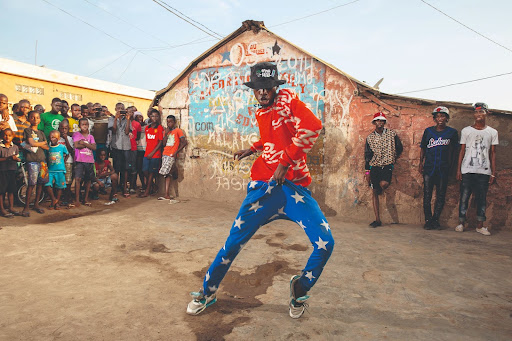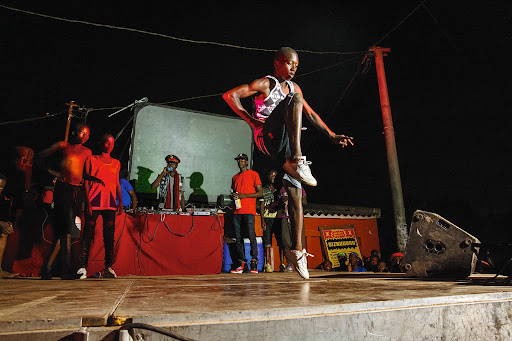Local kuduro event in the neighbourhood of Sambizanga, Luanda, 2015. (Photo: Anita Baumann)
This music encapsulated the moment. It is synthed up, but its smooth, tropical sound made it danceable and possible to play when acoustic and electric instruments were few and far between. The older generation of musicians dismissed it as overly influenced by zouk, but they danced to it nonetheless.
“Kizomba” is a Kimbundu word. It means “party”or “entertainment” (remember Coelho’s radio show Tondonya Mukina ó Kizomba?). Luís Esteves, a DJ, and the owner of the Luanda record store and distributor RMS which opened in 1994, remembers that the new form of dance — which developed to accompany zouk, and other Antillean music spun at the time, as well as the new sound produced by Angolan bands that had adapted those sounds with local rhythms, lyrics in Portuguese and stories of quotidian life — wanted for a name.
“Kizomba” worked. All-night parties at homes and discotheques gave the name resonance, even though some older musicians insist that it is a misnomer because it did not describe anything essential about the musical genre.
Kizomba had legs. Some Angolans left during the 1980s and 1990s, looking for better lives abroad. Kizomba knit Lisbon closer to Luanda and pulled Houston to Benguela. In the Portuguese-speaking African diaspora in Lisbon, it sank in deep. Lisbon’s African discos like Mussulo and Luanda (both Angolan-owned) and African ones like B-Leza featured kizomba stars and DJs that spun their music.
Cape Verdean and Guinean musicians released similar sounds. By the late 1990s, one could purchase cassettes on Luanda’s streets of the kizombas played in Luanda’s clubs by Cabo Love (Cape Verde), Roger (Guinea-Bissau), and the Lisbon-based Angolan group Irmãos Verdades. If you were unsure of the titles, young street sellers would sometimes break into tune.
Walking home from the archives one day, I crossed paths with some zungeiras (ambulant street vendors), cases of Coca-Cola piled high on their heads, belting out the hit song Yolanda as they trudged up the hill to the hospital Josina Machel. Kizomba played on radios in barbershops, in cars, in quintals and in nightclubs. In the tradition of semba musicians, kizomba songs, at their best, riffed on daily life.
Paulo Flores, with rare sensibility, humour, and poetic grace, captured the struggles and delights of life in 1990s Angola in CabelosdeModa (Stylish Hair). In this song, Flores indirectly criticises the tendency of young women to date what they think are older men of means. Mocking the practice, he counsels young men to play the game in reverse: dye their hair white, and put on a wedding band and a tie to attract the attention of young women.
 Kuduro fans performing in the neighbourhood of Sambizanga, Luanda, 2015. (Photo: Anita Baumann)
Kuduro fans performing in the neighbourhood of Sambizanga, Luanda, 2015. (Photo: Anita Baumann)
Other genres vied to be heard by the 1990s when, as S.O.S. band member Paim puts it, “prices replaced values” as the state opened the economy to the market. Gabi Moy’s song Vizinha Zongola re-energised semba, criticising nosy neighbours with lyrics in a mix of Portuguese and Kimbundu.
Os Versáteis brought fast-paced Kilapanga rhythms from northern Angola to kizomba and semba. Their hit Casamento (Marriage) highlighted the pressure on urban space caused by the war and its impact on romance: “Casamento, casamento, não! Seria uma loucura! / casamento, casamento, não! Seria uma aventura! / Não tenho uma casa / nem sei onde morar!”
Kuduro and urban durability
New nightclubs opened: Pandemónio in the downtown neighbourhood of Cazuno, Matié off Mutamba Square, Paralelo and Horizonte 2000 in Vila Alice, Animatógrafo and Contencioso near the Marginal sea promenade, and Navi-Hotel on the Ilha (Luanda’s peninsula). Young Angolans, who had travelled abroad,among them DJs, came back with CDs from Europe, including techno music that was soon played in Luanda’s clubs. Rappers like Big Nelo got their start in the early 1990s and by the mid-1990s the rap groups S.S.P. and N’ Sex Love hit the music scene rapping in Portuguese with thick Luandan slang.
At the same time, often singing in the same spaces, a new set of night-time “animators” appeared, chanting skeletal lyrics over techno-inspired sounds. New dances already began exploding from this music, with particular moves like gato preto (black cat) and açúcar (sugar). At the Banca Recreation Center, also in the neighbourhood of Cazuno, Sébem and Tony Amado threw lyrics over instrumental recordings like Bruno de Castro’s No Fear (recorded by the Angolan-owned and operated RMS label ― associated with the Luanda distributor ― based in Lisbon and recorded in Madrid in 1994).
Amado sang “Dança, dança, Van Damme, dança!” (Dance, dance, Van Damme, dance!) while imitating the Belgian action movie star’s stiff posterior swing from the film Kickboxer in his dance moves. This was just the latest iteration of transnational conversation ramifying in Angola music.
Woven around failed elections in 1992 and the return to war, as well as an unbridled rush into capitalism, this new music and dance transmuted exhaustion with the war, the violence done to male bodies in the process, and the decay of urban infrastructure into a 130 to 140 beats per minute, aggressive, bumping sound.
Unlike semba and kizomba, kuduro is not a partner dance. Danced alone, in desafios (challenges) on street corners or in musseque streets where a circle often forms, kuduro dance and sartorial panache reclaim urban space and the young male body. Dancers finesse control over the most minute muscle contractions, transforming them into waves, sweeps and acrobatic drops to the ground. Bodies mutilated by the war ― by mines, fighting, and the indignities of life lived under its duress ― are put back together in kuduro dance.
 Kuduro performers in the neighbourhood of Sambizanga, Luanda, 2015. (Photo: Anita Baumann)
Kuduro performers in the neighbourhood of Sambizanga, Luanda, 2015. (Photo: Anita Baumann)
Virgilio Fire’s successful 2001 song Kazacuta Dança, with its refrain “estamos sempre a subir!” (we are always on the up!), succinctly captured the unstinting hope, despite the desperate conditions, with which most Angolans lived as the war ground on. The song hit its zenith when the Luena Peace Accords finally ended the civil war in April 2002, and reason was pushed aside by delirium in the refrain’s resonance.
Using the computer programme FruityLoops and recording in small, musseque studios, kuduro, which got its start in downtown clubs, took off in the musseques. Aspiring kuduristas (kuduro artists) recorded the hits of other artists and one or two originals and burned a hundred CDs for a fee. They distributed these for free to candongueiro taxi drivers to promote their music.
Older musicians dismissed this as a short-term trend, describing it as “música descartavel (throw away music)”. Critics applauded acts like Puto Português, who moved from kuduro to semba, prompting one prominent commentator to call kuduro “children’s music”.
Musseque acts, full of menace, thick with rivalries, sometimes strung up with drug charges, like Os Lambas, received lashings in the press, but a huge following among musseque youth. In the meantime, a tiny group of kuduristas with a political edge have adopted the sobriquet “kuduro consciente” (conscious kuduro).
In the second decade of this century, kuduro garnered one powerful champion while most of the intelligentsia dissed or ignored it. Coreon Dú, the stage name of José Eduardo Paulino dos Santos, one of the sons of former Angolan president José Eduardo dos Santos, claims membership of the kuduro generation and allegiance to the genre.
He started the “I Love Kuduro” campaign and festival. The campaign employed a US consulting company, and it was rebranded as “Os Kuduristas”, an international festival of kuduro “dance, music, and lifestyle” that travelled to Berlin, Paris, Amsterdam, New York, and Washington, DC in 2012. Like semba before it, kuduro underwent the transition from political outsider to political insider, helping to rebrand Angola. It was not just about war any more, but becoming a new Dubai on the Atlantic — sun-soaked, insouciant and hip.
Like all urban dance music, kuduro constitutes a cultural dynamic that draws from diverse sources, be they internal or external, rural or urban, international or national, baixa or musseque. They cross social and class boundaries. The music thrives on mobility: moving in and around the city, from one city to another; first on radios and vinyl, on foot or in cars, and today through Bluetooth and MP3 — but still on foot and in vehicles too.
If semba helped create new political realities by crafting a sense of Angolanidade through the airwaves and on dance floors, kizomba forged a spirit of “can-do-ness” creativity during the fracturing years of the civil war, then kuduro has bridged the late war years to the petro boom, mediating capitalism and Angolanness again.
Young DJs are producing Afro-house and tweaking kuduro, pulling sounds from across borders both inside and outside Angola. Luanda’s dance floors will continue to vibrate with a diversity of music because Luanda’s DJs travel, even if they never physically leave the city.
Ten Cities (Spector Books/Goethe-Institut), a book on clubbing in Nairobi, Cairo, Kyiv, Johannesburg, Naples, Berlin, Luanda, Lagos, Bristol and Lisbon between 1960 and March 2020, is edited by Johannes Hossfeld Etyang, Joyce Nyairo and Florian Sievers. This extract, on the development of kuduro in Luanda, is the seventh in a series of 10 weekly excerpts from the book.